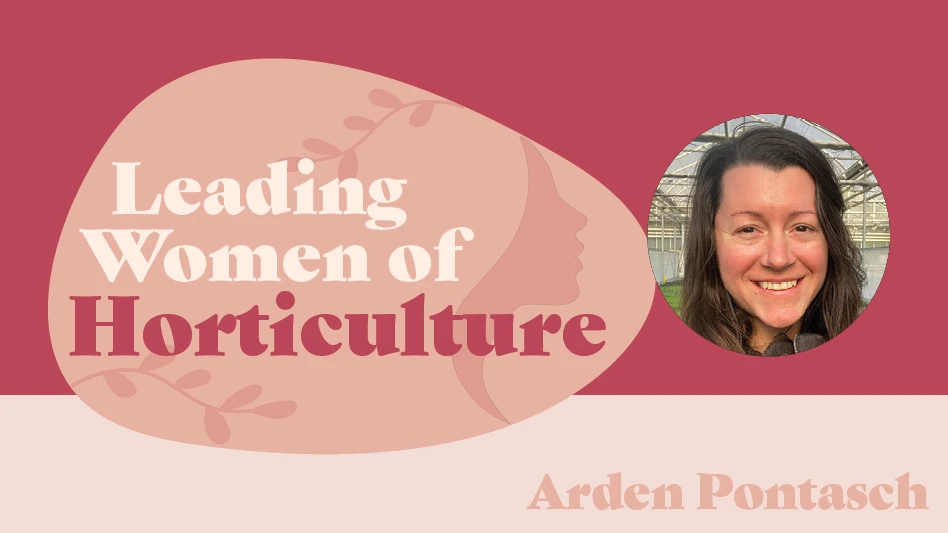
 Nestled in an unassuming part of The Ohio State University’s campus, a small staff of four full-time employees and several student volunteers and interns maintain the United States’ depository of plant material for six herbaceous plants. The center’s focus: Phlox, coreopsis, lillium, rudbeckia, begonia and viola.
Nestled in an unassuming part of The Ohio State University’s campus, a small staff of four full-time employees and several student volunteers and interns maintain the United States’ depository of plant material for six herbaceous plants. The center’s focus: Phlox, coreopsis, lillium, rudbeckia, begonia and viola.
The Ornamental Plant Germplasm Center maintains a collection of about 4,200 accessions – a term the center’s director, Pablo Jourdan, uses to describe the particular collection of a species that is stored at the center – 220 genera, and 1,050 species of herbaceous ornamentals that are distributed to investigators, breeders, and educators worldwide upon request. The majority of these accessions are conserved as seed in its own seed vault.
Plant germplasm is living tissue from which new plants can be grown. It can be a seed, a leaf, a stem, pollen or just a few cells that can be cultured into a new plant. The National Plant Germplasm System stores and catalogs germplasm of plants that might otherwise be lost. Each plant receives a number, and is catalogued in the system. Many varieties are passed down through the generations like a grandfather’s watch or other treasured heirloom. Plant Introduction No. 1 is a cabbage variety introduced from Russia in 1898.
There are 20 similar facilities, scattered throughout the U.S., including the Ornamental Plant Germplasm Center in Columbus, Ohio. The national system is geographically dispersed for a few reasons. First is the environmental variations that affect how and where plants grow. Second is that having many storage sites avoids the danger of losing the entire reserve if one location is destroyed.
A responsibility to the industry
While the seed vault at the National Seed Storage Laboratory in Fort Collins, Colo., looks like the warehouse from the ending of Raiders of the Lost Ark, the Ornamental Plant Germplasm Center resides in a much more humble abode. However, it serves the same mission. Since it was founded in 2001, Columbus’ OPGC has conserved genetically-diverse herbaceous plant germplasm of value to the floriculture and nursery industry. Their goals are to acquire, document, maintain, characterize and distribute herbaceous ornamental genetic resources and associated information for conservation, and to enhance scientific research as well as the floriculture and nursery industry.
“Our purpose first and foremost, is to make germplasm available to the industry,” Jourdan says, who’s also an associate professor in OSU’s Department of Horticulture and Crop Science. “Some of it involves maintenance activities like making sure we have seeds that are in good condition, and making sure we have the material people are interested in available, and making sure the collection we have is in good shape.”
New seeds are acquired from exploration, exchange with other germplasm banks or collectors. Inside the center, a map of the U.S. is dotted with pushpins showing the locations from which OPGC plant hunters have found and retrieved seed. Once it’s brought back to the facility, each accession is uploaded to the Germplasm Resources Information Network. This computer database contains records of all genetic resources preserved by the National Plant Germplasm Center.
Evaluate and enhance
 Intensive agriculture relies on genetic uniformity. But that uniformity increases vulnerability of a plant to pests and other stresses. Scientists must have access to genetic diversity to help bring forth new varieties that can resist pests, diseases, and environmental stresses. Jourdan says the caretaker and curator aspect of the center has always been and will always be its top priority. But his team does aim to make improvements where they can.
Intensive agriculture relies on genetic uniformity. But that uniformity increases vulnerability of a plant to pests and other stresses. Scientists must have access to genetic diversity to help bring forth new varieties that can resist pests, diseases, and environmental stresses. Jourdan says the caretaker and curator aspect of the center has always been and will always be its top priority. But his team does aim to make improvements where they can.
“The bulk of our work is not discovery,” Jourdan says. “But a part of what we do is research.”
Most of the research is focused on learning as much as possible about the seeds they protect and preserve, from their quality to their viability in storage.
Phlox is notorious for not having seed available. What is available is often very poor quality and very expensive. So seed biology in phlox is one of the major projects the center has undertaken.
Another research project focuses on powdery mildew resistance on phlox, and more broadly, how the different species relate to each other. From there, the researchers can determine if making crosses between them is feasible.
“For a lot of ornamentals, making crosses between different species is one way to capture interesting ornamental attributes,” Jourdan says.
The sensational six
The OPGC is currently focusing germplasm development efforts in six priority genera. These efforts include comprehensive acquisition, characterization and enhancement.
The genus Begonia may be the largest among Angiosperms as it consists of approximately 1,500 species and many more hybrids and cultivars. Together with Hillebrandia, it makes up the family Begoniaceae in the order Cucurbitales. Begonia species are herbaceous plants distributed primarily in moist environments of tropical and subtropical areas of Central and South America, Africa, and southern Asia.
Coreopsis is a North American native genus of approximately 25 species in the Asteraceae family. They are popular annual and perennial ornamental plants because of colorful and abundant flowers. Recent breeding activity with this genus has given rise to numerous new cultivars displaying a wide variety of flower colors.
Lilium is a genus of herbaceous flowering plants growing from bulbs. Most species are native to the temperate northern hemisphere. They comprise a genus of about 110 species in the lily family (Liliaceae).
Phlox is a genus of 65 species indigenous to North America; 22 highly variable species are native to the central and eastern United States. These species are classified into three clades based on phylogeny, karyology and phenotypic characteristics.
Rudbeckia is a genus of about 23 species native to North America, commonly called coneflowers or black-eyed susans. These herbaceous plants are members of the Asteraceae and are among the mosre popular native garden plants grown for showy yellow flowers.
The genus Viola includes the highly popular garden pansies and violets. The genus is quite large, consisting of approximately 500 species included in the family Violaceae and distributed worldwide. The OPGC is focusing on Viola species from the old world (Europe primarily) because these include the progenitors of the cultivated pansies and violas.
“You can create interesting color combination of flowers, different growth habits, or have longer flowering periods, or very importantly, disease resistance. Some of the more popular phlox have a problem with powdery mildew, but other phlox don’t. So we are trying to understand the differences between them and see how we can end up with a really good-looking, nice-flowering phlox that doesn’t get powdery mildew.”
The team is also working on hybridization and heat tolerance in viola species, seed production in begonia, and others.
“The bulk of our collection is in seeds,” Jourdan says. “It’s the way nature preserves them. Some of those seeds can last for centuries.”
The seed vault is kept at 40°F and 25 percent relative humidity to maximize the seeds’ survival time.
Continuing the collection
Most of the germplasm at the OPGC is propagated from seed; some is clonal. Seed supplies are increased when their numbers or germination percentage falls below a certain threshold. Controlled pollinations, either by hand or with bumblebees, are generally used to increase seed supply and maintain the original genetic variability and integrity of the germplasm. Cloned material is vegetatively propagated once a year, usually through cuttings.
Once they understand how best to germinate a particular seed, OPGC staff grow the plants out in the field, or in the greenhouse or in a raised bed.
Sometimes OPGC just can’t get seeds of the plants it wants. In these cases, its plant hunters go into the field.
“We get cuttings of those plants from the wild, we bring them into the greenhouse, we propagate it by potting them up and get them rooted,” Jourdan says. “Once the plants grow up a bit, we take additional cuttings to multiply the population. Then we use that population derived from cuttings of individual plants in the field to produce seed. Then we can store that material as seed.”
In a few cases, that method doesn’t work and the team ends up using tissue culture to propagate. OPGC uses tissue culture to simply maintain the plants they have to create stock plants.
“We want to keep them growing minimally so we don’t have to handle them as much,” Jourdan says. “The idea of conservation is not rapid multiplication. But the nice thing about in vitro on TC propagation, is that you can keep them healthy, but growing very slowly. You don’t have to be constantly handling them. The more you handle them, the more chances you have to make a mistake.”
The OPGC distributes small quantities of about 100 seeds per accession, seed lists, and other information free of charge to plant researchers worldwide. Jourdan says the only thing the center asks for in return for the germplasm is information about how the plant performed in their area. This helps them with crop improvement and research.
The National Center for Germplasm in Fort Collins preserves the back-up collection for all the germplasm in the entire system, including OPGC. The OPGC is a joint effort of the USDA-ARS and The Ohio State University’s Department of Horticulture and Crop Science. Financial support is provided through the Floriculture and Nursery Research Initiative of the ARS.
For more: www.opgc.osu.edu

Explore the December 2015 Issue
Check out more from this issue and find your next story to read.
Latest from Nursery Management
- Plant breeding as an art
- Society of American Florists accepting entries for 2025 Marketer of the Year Contest
- Sustainabloom launches Wholesale Nickel Program to support floriculture sustainability
- American Horticultural Society welcomes five new board members
- Get to know Christopher Brown Jr. of Lancaster Farms
- American Floral Endowment establishes Demaree Family Floriculture Advancement Fund
- The Growth Industry Episode 3: Across the Pond with Neville Stein
- The Growth Industry Episode 2: Emily Showalter on how Willoway Nurseries transformed its business






